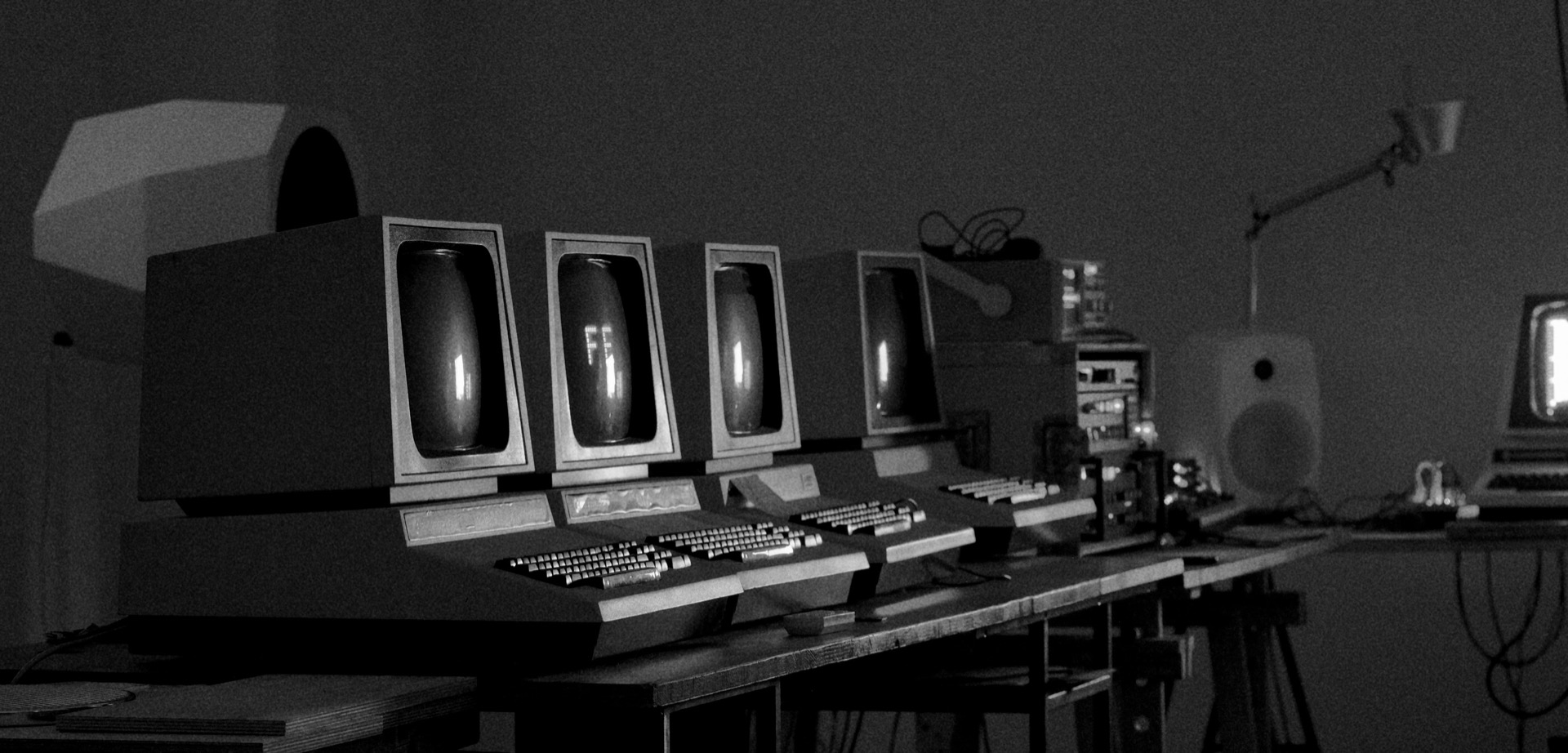CBM 8032 AV
computer graphics and sound [2016-2023]
CBM 8032 AV is a journey into the beauty of abstract graphics and sound, created with five iconic early personal computers. The work is about the ambivalence between a contemporary aesthetic and the usage of obsolete limited technology from more than forty years ago. Everything could have been done already in the 1980s, but it needed the cultural backdrop of today to come up with the artistic ideas driving it.
When artists began to explore computers as medium in the 1950’s, technology was limited and the resulting minimalism in expression was a necessity. Half a century later, the sight of a green cathode ray tube display - once the promise of an exciting future - becomes both nostalgic and a novelty.
CBM 8032 AV is performed with five Commodore CBM 8032 computers, each with a single 8bit CPU running at 1MHz and with 32kByte of total memory.
These machines were never meant to be used for the creation of audiovisual art, and the results are slow, harsh, geometric, with low resolution and exclusively in monochromatic green. Yet they radiate their very own groove and visual appeal.
The sonic spectrum includes digital noises, deep gritty sine waves, sparse clicks and glitchy percussions: very cut-up and metrical, with interwoven quiet or even silent moments, further processed and refined with studio electronics from the early 1980s.
Work on CBM 8032 AV started in early 2016. The premiere was on October 11 2019 at Unsound Festival in Krakow. The performance has been refined and developed further till 2025.
CBM 8032 AV has been awarded Best Production of the 67th International Festival of Contemporary Music - La Biennale di Venezia in 2023.
An in-depth technical description of the project can be found here: Inside CBM 8032 AV
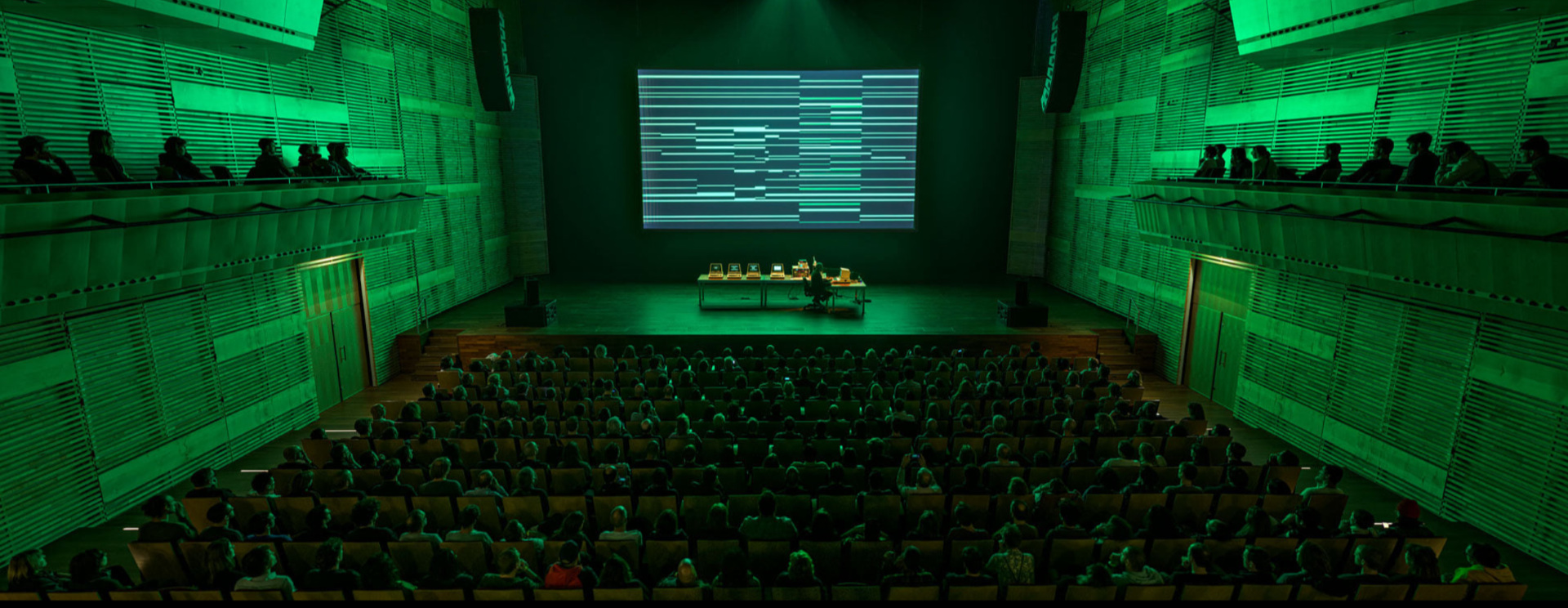
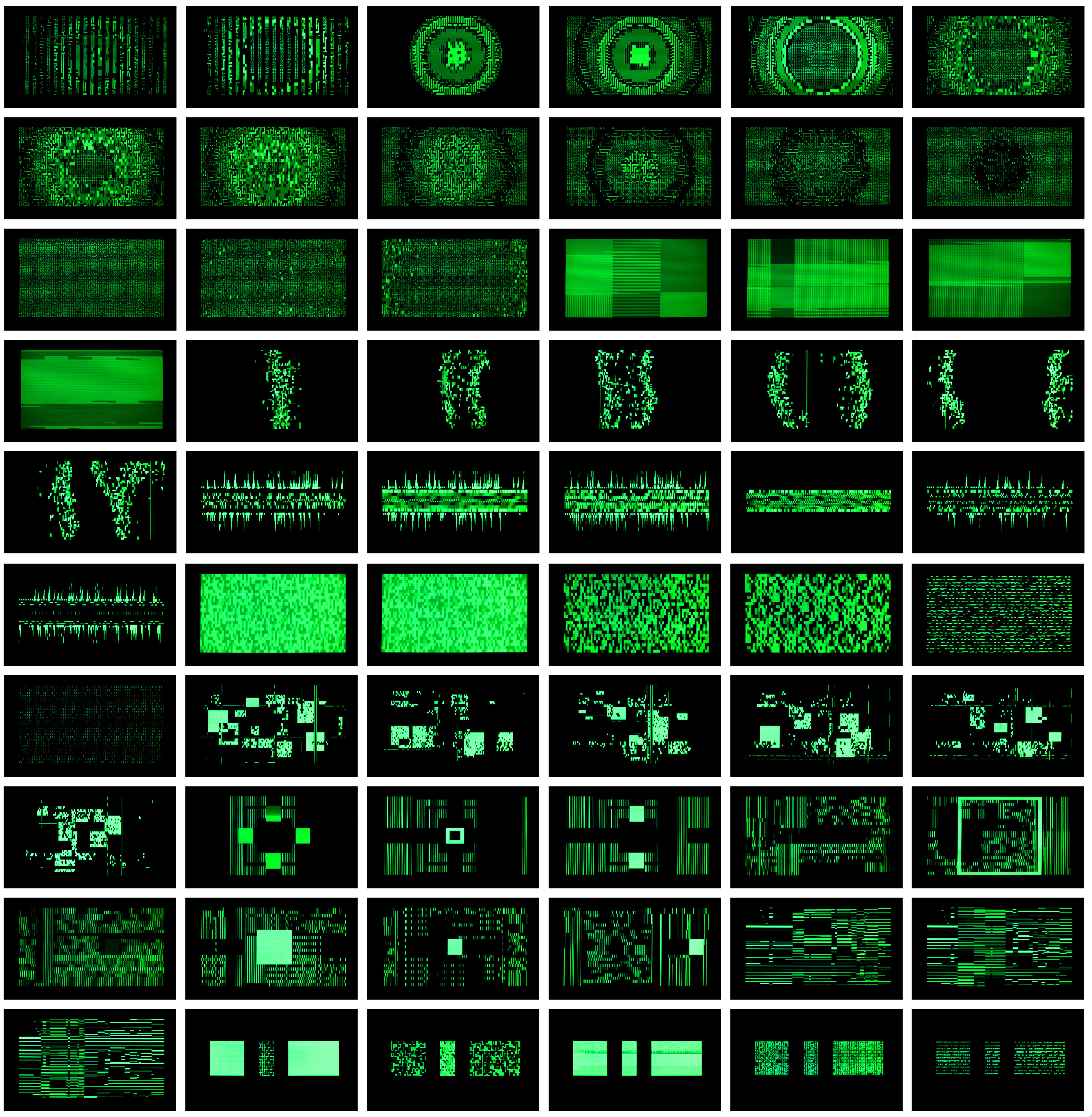
Performance and Composition
The computers on stage are running custom software developed by the artist and his team. Three of them create sound, one machine is responsible for graphics and one is controlling the others, with their displays facing the audience. A large projection at the back of the stage is mirroring the output from the video graphics computer.
The performance starts with an introduction by the artist, providing historical background and context. The first musical piece is an improvisation, and the screen of the sequencer is projected to give insight into the creative working process.
Starting with the second piece, the video computer is creating synchronised graphics. The concert consists of several pieces, each with their own visual language, based on a dedicated graphics algorithm.
The act of performing is operating the main computer: recalling and modifying audiovisual patterns, changing parameters, controlling the progression of the pieces in time. It involves a lot of key pressing, together with sound adjustments on a mixing desk and a rack with early 1980's digital audio effects processors.
Whist the succession of pieces is fixed, their individual structure, duration and articulation is subject to improvisation and spontaneous interactions.
The concert's final piece ends with a harmonic drone slowly getting lower in pitch and a steady reduction of graphic elements on screen until it is completely dark and only the deep drone sound is left over, which continues during the last part of the concert, the credits. The sequencer computer is displaying the names of the people involved and more technical details of the computers in a visual style reminiscent of early terminals.
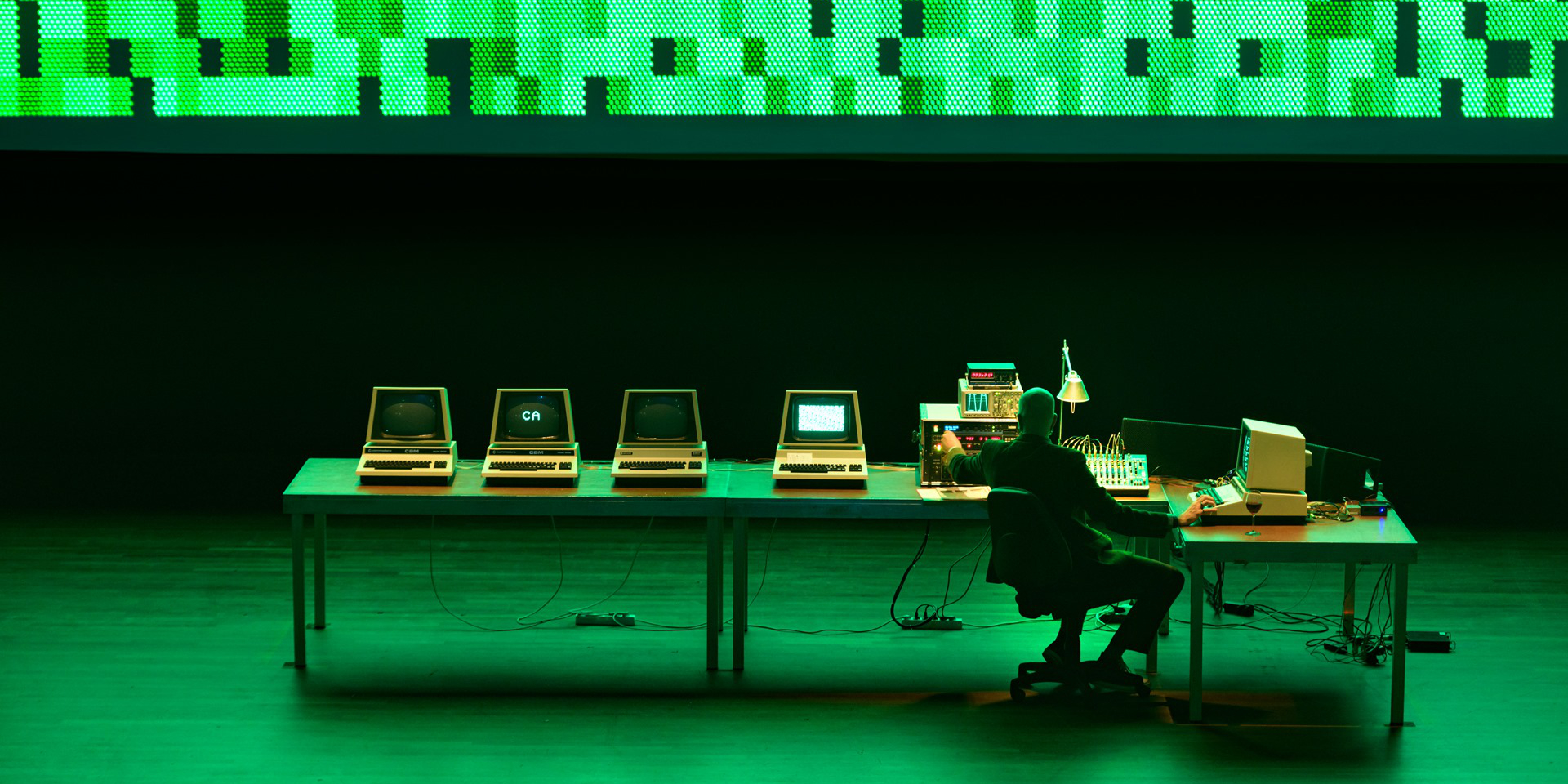
History
The CBM 8032 computers are the grandfathers of the successful C-64, and directly descend from the "PET 2001" series. Unlike the C-64 they had no sound chip, no colour and no pixel graphics, just text and symbols. They were used in labs, for controlling industrial machinery, in offices and for education. They are iconic objects from the beginning of the personal computer area, and they operate with the same CPU as the Apple I and Apple II computers.
This chip, a MOS 6502, was deliberately designed as an `affordable` microprocessor, and it hit the market in 1976.
The Commodore CBM 8032 itself was released in 1980, at a time in computer history, when a lot of groundbreaking work was done that shaped the world we live in.
The invention of the microprocessor a decade earlier lead to such diverse results as video game consoles, digital synthesisers, pocket calculators and smarter washing machines. It turned hippies into computer nerds, and later into billionaires. It changed technology and industries, but also culture on many levels from cinema to poetry, from music to graphic design and beyond.
There is a fundamental difference between these machines and contemporary computer technology: When our audio or video routines are running, the computers do nothing else than byte by byte executing what we told them to do.
There is no black boxes, no background tasks, no dependencies on external frameworks, not even an operating system, no data in the cloud, libraries, and everything else that is happening today in even the most basic computer systems.
The technology is limited but it is all ours. CBM8032AV can be updated as long as the artist is interested in doing it, and it will not change if the artist does not intend to do so. There will be no operating system updates for the computers, there will be no suddenly incompatible hardware, or third party extensions that do not work in new contexts.
The artist is completely in control of the results, and can fully predict and understand the process and the outcome. In the light of the current developments in AI and its repercussions on art production, this is a radial position. For CBM8032AV the question of authorship and of origin can be answered unambiguous.

Technical Background
By programming the sequencer, the graphics- and sound -routines directly in assembler, the code which is understood by the microprocessor itself, it is possible to get video and sound out of a machine that is several hundred thousand times less powerful than a cheap computer from 2020.
In assembler, the code literally directs the data flow through the CPU. This requires a highly abstract way of thinking, but allows to write code that can be executed extremely efficient and fast.
The CBM 8032 displays graphics on a green 12" cathode ray tube display with 25 lines of 80 characters.
Each of the 2000 screen positions can display one of 255 possible letters and graphical symbols, defined by Commodore’s PETSCII character set [see screenshot above]. The CBM 8032 AV project is exploring this unique quality.
A built-in piezo speaker allows to play sound via a single 1 bit output channel, used mainly for providing simple audio feedback for user actions. The resulting sonic spectrum and frequency range is very limited.
However, these computers invite users to build hardware additions: They provide connectors on the mother board allowing to extend the functionality. Commodore also published the required circuit diagrams and information about essential parts of the software architecture of their computers. The idea that users extend them to fit their own needs was actively encouraged.
We developed additional hardware for audio output, video signal mirroring and for networking the computers.

Motivation
I was a teenager in the 1980s, in a family of engineers, and amazed and curious about technology. My first practical encounter with a computer was with a smaller version of the CBM 8032, the CBM 4016, on which I learned programming BASIC at high school. It was also based on the MOS 6502 CPU, which belongs to the last generation of (8 bit) microprocessors that could still be directly programmed by human beings without the aid of other computers or software packages. A printed book with a list of opcodes and registers is sufficient.
When I look at circuit diagrams of machines built during that period, I experience a time travel to an era in which developers had to came up with amazingly elegant solutions for problems, since they had to deal with very limited resources.
The computer code and the hardware represents the Bauhaus theme of 'form follows function' out of necessity. There is amazing beauty in this.
I experience it when coding the graphics and sound routines for the 8032 series project. When I started in 2016, I soon saw a chance to create something which resonates with me and is artistically valid. Because of the reduction, because of the raw-ness, because of the timeless beauty of green characters on black background. Because there is no state-of-the-art technology of today involved at all.
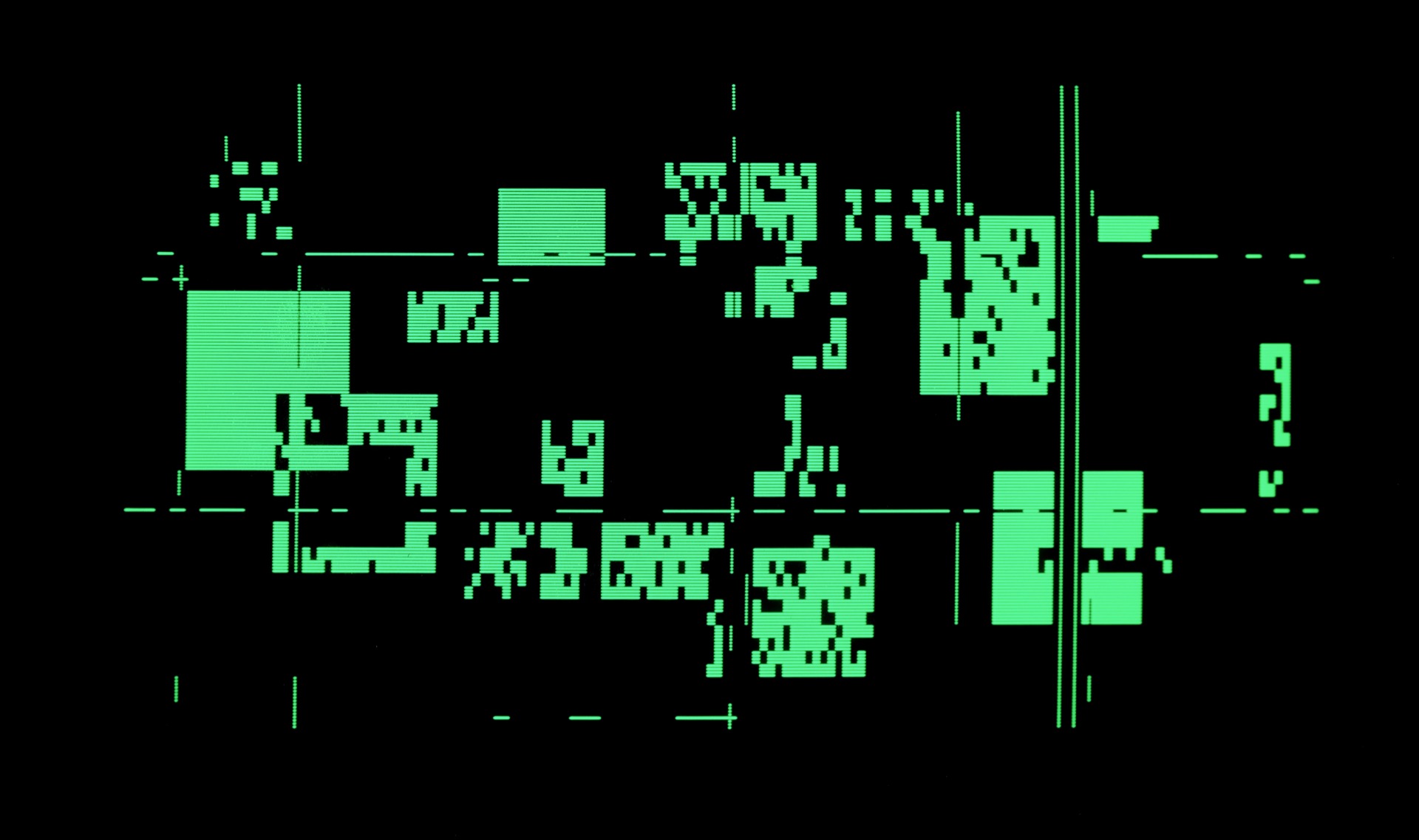
The realisation of the 8032 AV project included many steps, it forced me to learn the 6502 assembler language, to understand the circuit board design of the 8032, and to put myself inside the heads of the people who invented that machine.
It required building new hardware around it. And it required thinking about the generation of sound and graphics in terms far more abstract than with any contemporary tool.
It also required collaboration: Writing all the software and building the hardware additions became too much for one person. In 2019 we were a team, working together on making this idea become reality.
The CBM 8032 AV project is as much a technological adventure as an artistic research project. It is impossible to separate one from another and this is partially what makes it special and rewarding.
The attempt to use forty year old computers to create a concert work seems irrational and counter-intuitive at first glance. Why putting an enormous effort into pushing an outdated technology to the limits? Why not exploring the vast offerings of today instead? During the last years of growing occupation with the idea and execution of the project these questions became essential and lead to multiple moments of doubt. Yet, the deep satisfaction whenever a new idea had been turned into running code, producing a new sound or new moving graphics, provided the answer.
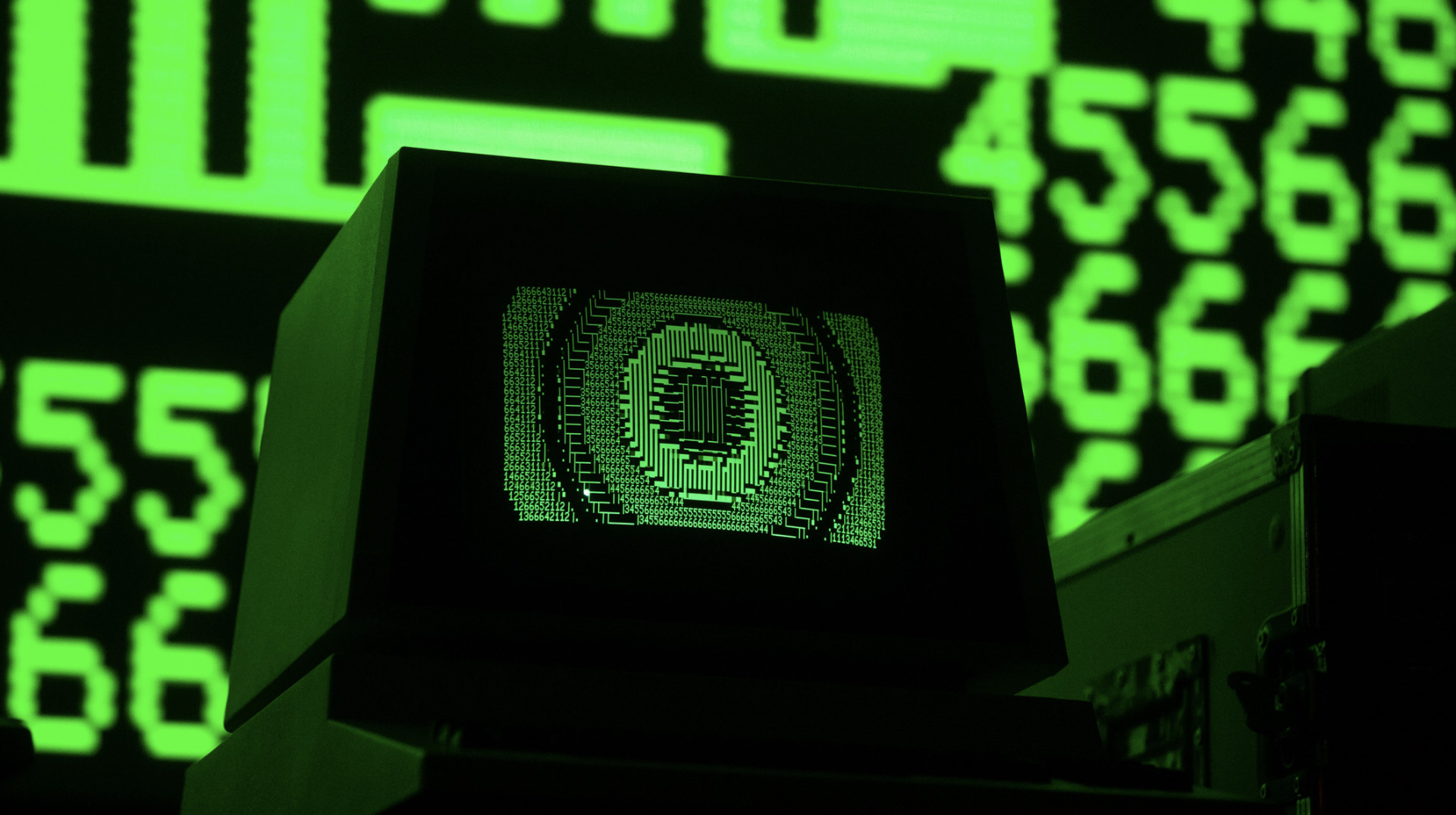
Art.Science.Technology
Art is often attributed with the irrational and the emotional, whilst engineering and science are painted as the opposite; clear, structured, logical and entirely driven by reason. This picture is flawed, both for the arts and for science and engineering.
To avoid being arbitrary, the creation of art is highly concerned with structures, rules, and methods. And science needs intuition to work, relies on the ability to think the previously unthinkable. Building computers and programming them is no exception. Whilst working on the CBM 8032 AV project we had to involve ourselves deeply with the architecture of the hardware we are using, we had to gain an understanding about signal flows, states, connections and timing sequences, in search for the beauty within.
We had to learn programming those machines on the lowest possible level of human - computer interaction, in machine language and assembler, turning formal commands ultimately into a sequence of bits in RAM, ready to be executed directly by the CPU. We were forced to think in a high level of abstraction, deeper and more reduced than in any modern programming environment.
This could be perceived as tedious and ridiculous today, but it enforces a conceptual clarity that suggests a similarly rigid logic for the project's artistic side.
Decisions had to be derived from the palette of possible options, in a dialogue with the available technology from 1980, and by doing so also in a dialog with the people who invented these systems.
At the end each human - machine interaction is a human to human interaction, since humans built the machines in the first place.
The CBM 8032 computer was simple enough to be understood and constructed by only a handful of people, and their decisions shaped the product and how its used. The PETSCII set of graphic symbols is a great example for this. CBM 8032 AV utilises this palette of shapes, which someone back in the 1970s designed. Forty years later, we make use of them to create something new.
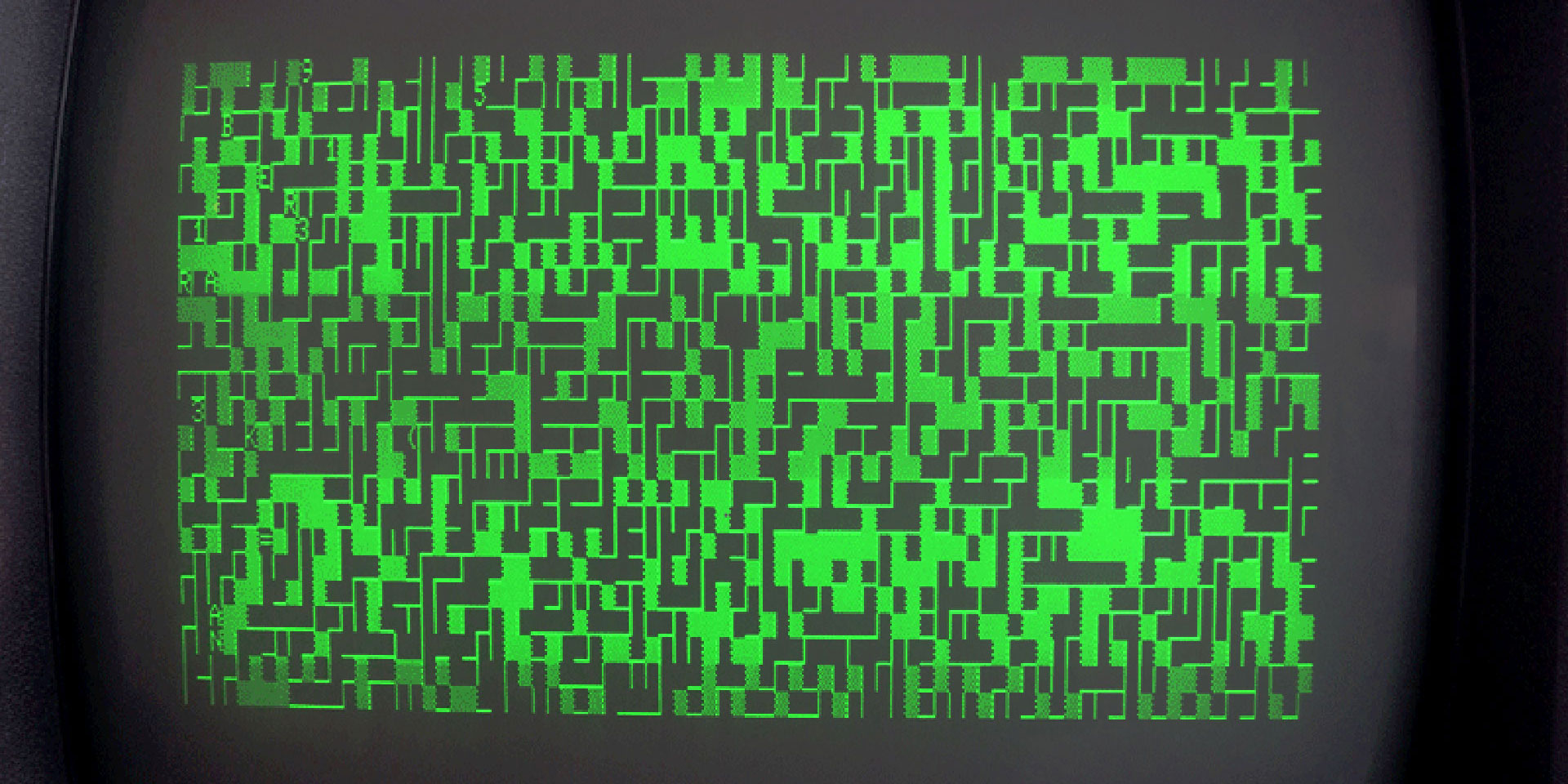
Ancient Beauty
The work on CBM 8032 AV changed my way of thinking about programming. The extreme limitations and simplicity of the 6502 microprocessor turns it into a Swiss knife once mastered. Completely taking over a computer system to do nothing but running our own code, clock cycle per clock cycle, one million times per second, is an experience of power that is very different from being a guest on a contemporary environment, where thousands of processes run at the same time, most of them unnoticed and out of control by the user.
Additionally, there are specifics of ancient technology that even outperform current standards in some regards:
My sound routines are driving directly two eight bit DA converters, with no concept of a fixed sample rate: The distance between two samples is the time it takes to run the code. It is possible to produce textures with that which are hard to achieve with a current system.
And the longer we were looking at the computer's green cathode ray tube ('CRT') displays, the more we became aware of the beautiful smooth and soft decay of brightness when a character is turned off, and the extreme difference between illuminated parts and darkness. Monochrome CRT displays were amazing technology, and whilst being heavy and having low resolution, we lost a unique and magical visual quality when moving on to our modern retina displays.
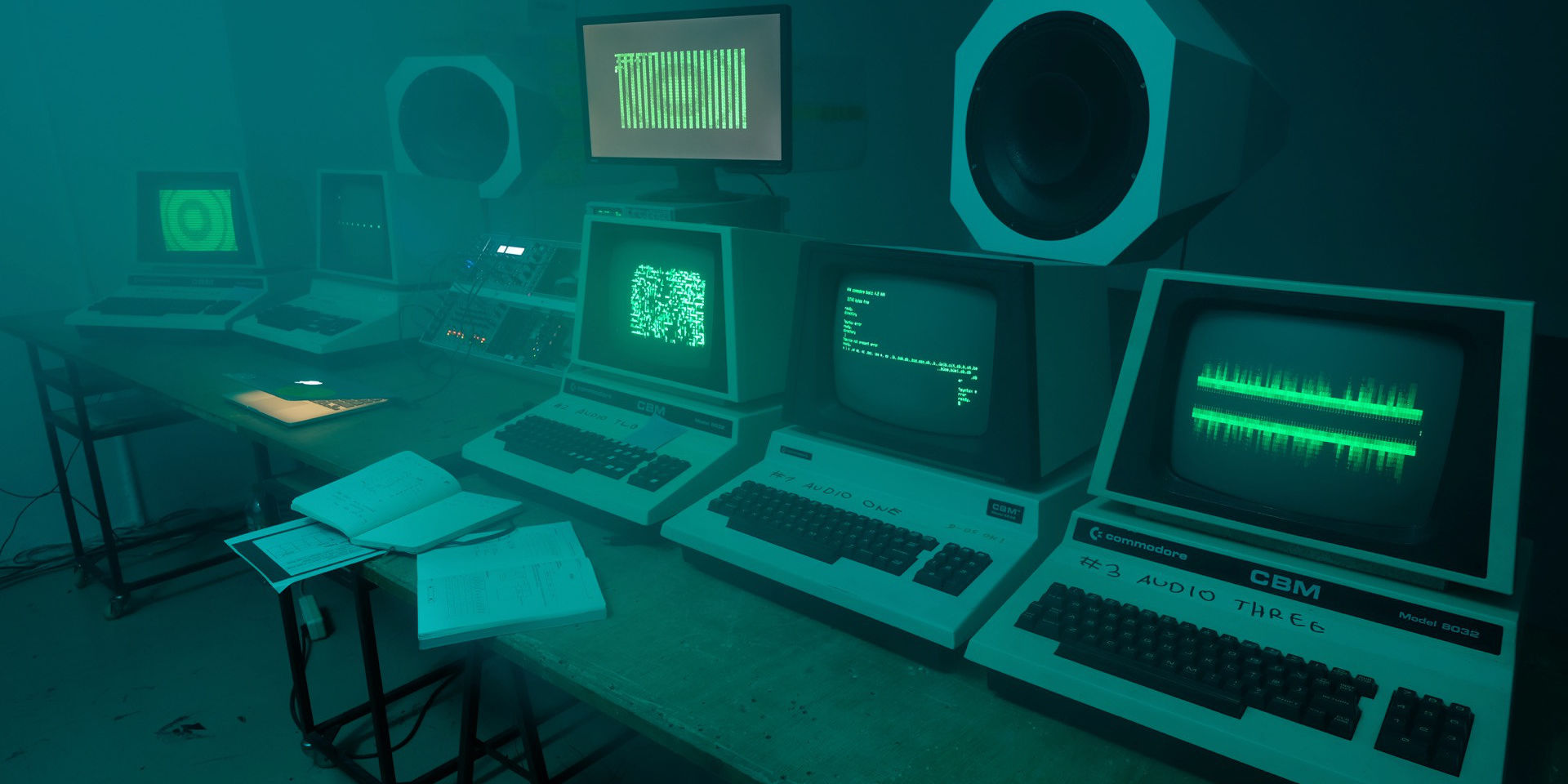
The CBM8032AV project is a dialogue with technology: What can we make machines do? How difficult will it be? What do they offer? Where is something new to discover? Which new ideas do they seed?
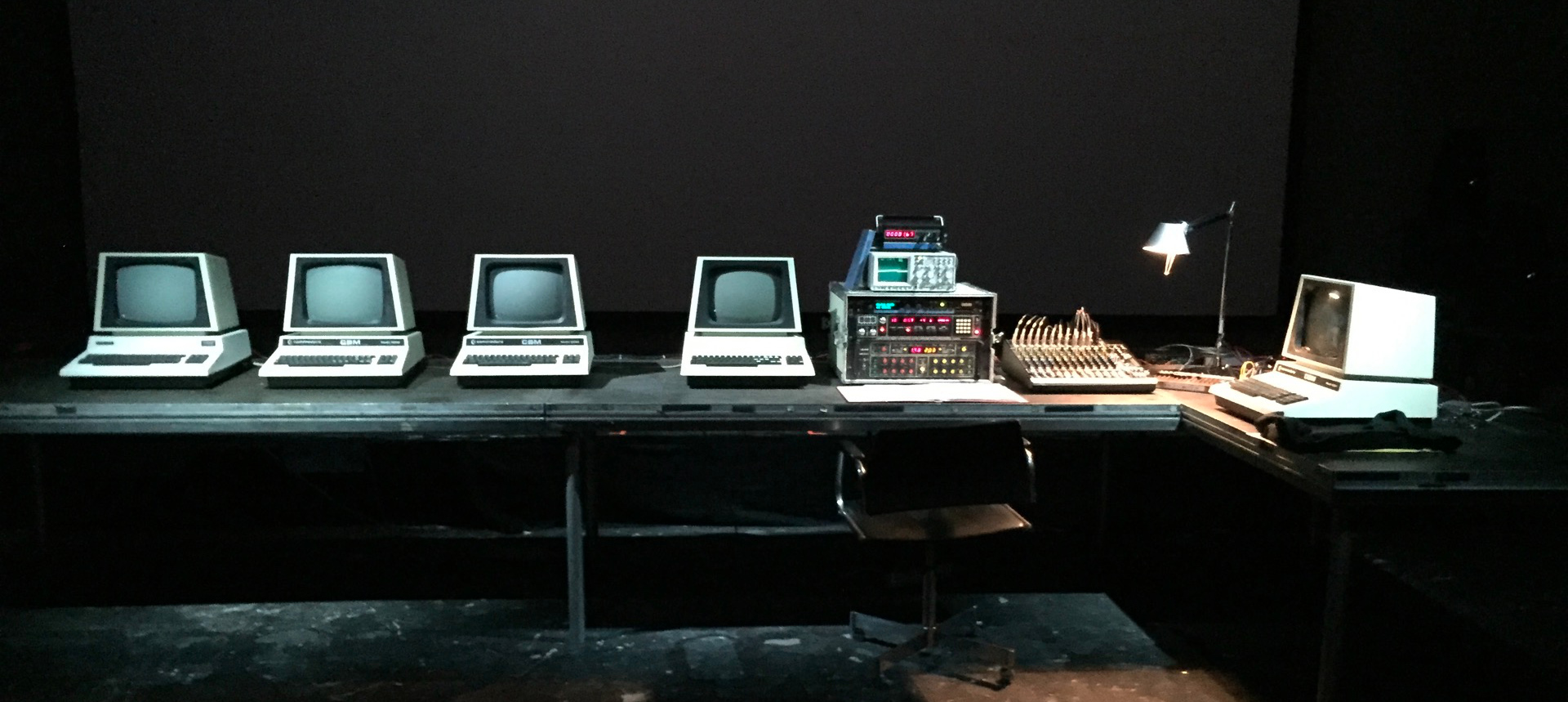
Photo on top of page and above 'Art.Science.Technology' taken at the premiere by Mihály Podobni
Credits
Already in 2018 it became clear that this project is going to be too big to be done by a single person. CBM 8032 AV would not exist without the invaluable contributions of many people, most notably Anna Tskhovrebov, who wrote the initial graphic routines and turned my step sequencer concept into code.
Ralf Suckow, Ian Hobson, Joshua Batty and Mitchell Nordine built the hardware and software extensions needed to get graphics from the old CRT displays out in HDMI format. Colin Fraser, Michael Sollinger and Sebastian Wolf contributed general circuit board development expertise.
Mihály Podobni was and still is making sure computers and crew travel safely around Europe. And a lot more people contributed at some point to this project. A big thank you! to all of you.
